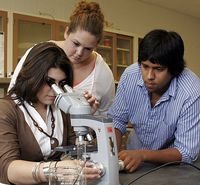For this topic you will be asked to organise a teaching observation as part of the portfolio activity. That is arrange for someone to observe the session and give you feedback on your planning and facilitation. We suggest you use the teaching observation template as a guide to the observer giving feedback. To download this file, you may be asked to log into Moodle. The components of the template may influence how you plan to facilitate the session so it can serve as a guide to the faciitation methods you may choose.
You can use this feedback when critiquing your session. As this is only one way for you to get feedback on your session, further options are covered in the next topic: Critiquing a session.
Use a range of facilitation methods
Using a range of teaching methods helps meet diverse learning needs and preferences and helps keep learners engaged.
We can categorise learning activities depending on whether learners learn on their own (individual) or whether they work in pairs or small groups or as a whole class.
To cater for diverse learning needs and preferences, it can be very helpful to incorporate each of these types of activity during a session or sequence of sessions:
Click on the expand button  to the right of each type of activity for more information:
to the right of each type of activity for more information:
| Individual activities
|
- Contract learning
- Independent learning
- Individual practice
- Computer Assisted Instruction/Learning (CAI/CAL)
- Project work
- Web-quests
Brett's tips for success
|
For individual activities, I think these things are essential.
- Very clear written instructions so that learners know exactly what they have to do and can work on their own without getting lost or confused.
- Effective facilitation - for example, explaining the activity beforehand, and being on hand to answer questions during the activity.
|
|
| Pair/group activities
|
- Discussion groups
- Buzz groups
- Debate
- Games
- Problem-based scenarios
- Project work
- Tutorials
- Web-quests
Brett's tips for success
|
Again, I think we need two things.
- Very clear instructions so that learners in the groups know exactly what they have to do and can work on their own without getting lost or confused.
- Effective facilitation - for example, explaining the activity beforehand, and monitoring the activity by checking in on each group to see if they have questions, are stuck or off track.
|
|
| Class activities
|
- Brainstorming
- Mind-mapping
- Demonstration
- Field trip
- Guided question and answer
- Games
- Laboratory
- Modelling
- Panel of experts
- Role play
- Seminar
- Case study
- Simulation
- Workshop
- Lecture
Brett's tips for success
|
For me, one of the key aspects of whole class activities is the questions I ask the students.
- I find open questions (where there is not just a yes/no or right/wrong answer) very helpful to generate discussion.
- If someone hasn't contributed a lot of ideas, I sometimes direct a question to them by name if I think they are able to answer confidently.
In our professional development sessions, I've used this page on Asking Questions to Improve Learning which has some great pointers for teachers.
PS: one of the guys in my team found it hard to facilitate a brainstorm in class while recording the ideas on the whiteboard - I suggested he get one of the students to do the recording on the board while he just facilitated the discussion. It worked a treat, and now it's a regular part of his sessions!'
|
|
Structure your session
Creating a logical and engaging structure for the session helps learners develop concepts and keep focused.
Click on the expand button  to the right of each stage of the session for more information:
to the right of each stage of the session for more information:
| At the start
|
- Go over what you did in the last session.
- Ask questions to help students link the last session to today's session.
- Outline what you are going to cover in the session and what activities have been planned – diagrams can be helpful.
- Make sure that the students know what they will have achieved by the end of the session.
- Start the teaching session with something interesting that will get your students' attention - such as a quote, video, podcast, photo, cartoon, statement, etc.
|
| During the session
|
- Do your teaching in 'chunks' - that is, break it into short segments of activity and content.
- Develop a way in which you and the students can link the chunks into a whole. Don't be afraid to repeat things – highlight them on the board.
- Add variety to your delivery. Get students involved in the teaching and use group feedback to drive your session.
- Good teaching includes repetition – tell them what they are going to do, get them to do it, tell them what they have just done!
|
| Concluding the session
|
- Review what has been covered. (See Brett's tips below.)
- Formally conclude the session so that students know they have finished.
- Gather some quick feedback from learners - how well did the session meet their needs? You could display two or three questions and get them to respond with a numerical code for each - e.g., written on slips of paper or via text message. If you need some ideas on how to gather feedback from learners, check out the Evaluation methods page in the next topic.
- Ensure the students know what will be happening next session and what your expectations are for home study and their reflection on what was covered in class.
- It can be useful to build in time at the end of the session for questions, catch-up and chat.
- At the end of the session, acknowledge the class. Don't rush out of the room. There may be some students who have questions or comments they want to make. This is why you finish teaching before the end of the allotted time.
Brett's tips for success
|
I used to go over what we had covered at the end of each session but found that learners didn't really pay a lot of attention.
Now, I prefer to end every session by asking questions to draw from the learners the main points in order to build a quick summary of the session. They have to tell me what we have covered - it's much more effective!
|
|
Activity
Read through the following pages and complete the suggested activities.
- Divide them into two groups; methods resulting in passive learning and methods resulting in active learning. Consider the methods you use in your teaching; do they result in passive or active learning?
|
Activity
|
Facilitate a session:
- Arrange for someone to observe the session you intend to facilitate using a lesson plan that you have created. We suggest you use the teaching observation template as a guide to the observer giving feedback. To download this file, you may be asked to log into Moodle.
- After the session, record your reflections using these questions:
- What went well and why?
- What didn't go so well and why?
- What would you do differently next time and why?
- Also, meet up with the observer and discuss their feedback.
|
Acknowledgement: sections of this topic have been based on Ako Aotearoa's Signposts publication (CC-BY-SA).

|

![]() to the right of each type of activity for more information:
to the right of each type of activity for more information:
![]() to the right of each stage of the session for more information:
to the right of each stage of the session for more information:

